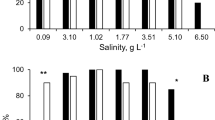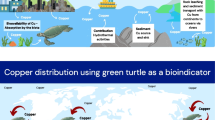Abstract
Measurements of dry weight, carbon- and nitrogen contents together with the body length of important zooplankton from the Inland Sea of Japan were made using freshly caught specimens. The values of the former three parameters were found to be highly correlated to length, and species specific regression equations were calculated for 10 species of Copepoda (Calanus sinicus, Euchaeta plana, E. concinna, Centropages abdominalis, Sinocalanus tenellus, Acartia clausi, A. tsuensis, Tortanus forcipatus, Oithona brevicornis andO. similis), 3 species of Cladocera (Podon leuckarti, P. polyphemoides andPenilia avirostris), 1 species of each of Mysidacea (Neomysis japonica), and Natantia (Acetes japonicus), and two forms of Chaetognatha (Sagitta crassa andS. crassa f.naikaiensis).
Similar content being viewed by others
References
Beers, J. R. (1966): Studies on the chemical composition of the major zooplankton groups in the Sargasso Sea off Bermuda. Limnol. Oceanogr.,11, 520–528.
Beers, J. R. (1976): Determination of zooplankton biomass.In, Monographs on Oceanographic Methodology. 4. Zooplankton Fixation and Preservation, ed. byH. F. Steedman, Unesco Press, Paris, pp. 37–84.
Curl, H., Jr. (1962): Standing crops of carbon, nitrogen and phosphorus and transfer between trophic levels, in continental shelf waters south of New York. Rapp. Proc. -Verb. Cons. int. Explor. Mer.,153, 183–189.
Durbin, E.G. andA. G. Durbin (1978): Length-weight relationships ofAcartia clausi from Narragansett Bay, R.I. Limnol. Oceanogr.,23, 958–969.
Hirota, R. (1981): Dry weight and chemical composition of the important zooplankton in the Setonaikai (Inland Sea of Japan). Bull. Plankton Soc. Japan,28, 19–24 (In Japanese with English abstract).
Ikeda, T. (1974): Nutritional ecology of marine zooplankton. Mem. Fac. Fish., Hokkaido Univ.,22, 1–97.
Kamshilov, M. M. (1951): Determination of weight ofCalanus finmarchicus on the basis of body length measurements. Dokl. Akad. Nauk SSSR,74, 945–948 (In Russian).
Krylov, V. V. (1968): Relation between wet formalin weight of copepods and body length. Oceanology (Engl. transl. pub. by Amer. Geophys. Union),8, 723–727.
Landry, M. R. (1978): Population dynamics and production of a planktonic marine copepod,Acartia clausi, in a small temperate lagoon on San Juan Island, Washington. Int. Revue ges. Hydrobiol.,63, 77–119.
Omori, M. (1970): Variation of length, weight, respiratory rate and chemical composition ofCalanus cristatus in relation to its food and feeding.In, Marine Food Chains, ed. byJ. H. Steele, Oliver and Boyd, Edinburgh, pp. 113–126.
Omori, M. (1978): Some factors affecting on dry weight, organic weight and concentrations of carbon and nitrogen in freshly prepared and in preserved zooplankton. Int. Revue ges. Hydrobiol.,63: 261–269.
Onbé, T. (1974): Studies on the ecology of marine cladocerans. J. Fac. Fish. Anim. Husb., Hiroshima Univ.,13, 83–179 (In Japanese with English abstract).
Pearre, S., Jr. (1980): The copepod width-weight relation and its utility in food chain research. Can. J. Zool.,58, 1884–1891.
Pertsova, N.M. (1966): Average weights and sizes of abundant species of zooplankton in the White Sea. Oceanology (Engl. transl. pub. by Amer. Geophys. Union),7, 240–243.
Petipa, T. S. (1957): On average weight of common forms of zooplankton in the Black Sea. Trudy Sevastopol biol. st. Akad. Nauk SSSR,9, 39–57 (In Russian, cited fromPertsova, 1966).
Robertson, A. (1968): The continuous plankton recorder: a method for studying the biomass of calanoid copepods. Bull. Mar. Ecol.,6, 185–223.
Shmeleva, A.A. (1965): Weight characteristics of the zooplankton of the Adriatic Sea. Bull. Inst. Oceanogr. Monaco,65 (1351), pp. 1–24.
Studenikina, Y. I. andM. M. Cherepakhina (1969): Average weight of the main forms of zooplankton in the sea of Azov. Hydrobiol. J.,5, 74–76 (Cited fromPearre, 1980).
Author information
Authors and Affiliations
Rights and permissions
About this article
Cite this article
Uye, Si. Length-weight relationships of important zooplankton from the Inland Sea of Japan. Journal of the Oceanographical Society of Japan 38, 149–158 (1982). https://doi.org/10.1007/BF02110286
Received:
Revised:
Accepted:
Issue Date:
DOI: https://doi.org/10.1007/BF02110286




